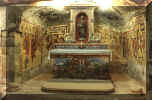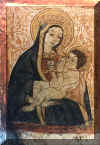 According
to a strong local tradition, during the persecution of the Roman Emperor
Trajanus Decius (AD 249-251), Agatha, together with some of
her friends, fled from Sicily, her native land, and took refuge in Malta.
According
to a strong local tradition, during the persecution of the Roman Emperor
Trajanus Decius (AD 249-251), Agatha, together with some of
her friends, fled from Sicily, her native land, and took refuge in Malta.St. Agatha's Historical Complex
CRYPT
Click on the thumbnails to view full size image
 According
to a strong local tradition, during the persecution of the Roman Emperor
Trajanus Decius (AD 249-251), Agatha, together with some of
her friends, fled from Sicily, her native land, and took refuge in Malta.
According
to a strong local tradition, during the persecution of the Roman Emperor
Trajanus Decius (AD 249-251), Agatha, together with some of
her friends, fled from Sicily, her native land, and took refuge in Malta.
Some historians believe that her stay on the island was rather short, and she spent her days in thr crypt at Rabat, in prayers and teaching the Christian Faith to the children. After some time, Agatha realized that it would be better for her, to return to her native land and witness for her faith there, even at the risk of martyrdom.
On landing in Sicily, Agatha was arrested and brought before Quintanus, praetor of Catania, who condemned her to torture and imprisonment. After a few days, on the 5th of February 251, she died in prison as a martyr.
Our fore-fathers dedicated in her honour the same crypt where she used to pray and named after her a nearby Catacombs and later on a Church over the crypt.
The crypt of
St. Agatha is hewn in live rock. It is an underground basilica, which from early
ages was venerated by the Maltese. At the time of St. Agatha's stay, the crypt
was a small natural cave which later on, during the 4th or 5th
century, was enlarged and embellished.
embellished.
At the far end of the crypt, there is the main altar dedicated to the Saint. Till 1647, this altar was still used for worship.
When Mgr Lucas Buenos was bishop of Malta (1664-1668), he visited this sacred place, and donated to the crypt an alabaster statue, representing the saint undergoing her martyrdom. It is a fine work of art, sculptured in Trapani, and represents the Saint tied to a tree trunk and a small puttino is holding a crown of roses above her head. The statue is set on a baroque pedestal within which, there is a tiny statue of the Saint put on fire.
Nowadays, this statue could be admired in the Museum. In its place, there is a new fibre-glass statue of the saint, the work of the Maltese artist, Anton Agius.
In the acts of the pastoral visit by Mgr Pietro Duzina in 1575, there is recorded that there were many altars in the crypt. Nowadays, only two remain. The main altar and a side altar dedicated to Our Lady, Mother of Divine Grace.
The
crypt is adorned by a good number of frescoes. Some of them date back to the 12th
cent ury and are in Byzantine style. The others, which are in Greek style, date
back to the 15th century (1480). There are 30 images of saints, out
of which, 13 represent St. Agatha. The remainder represent bishop saints, virgin
and martyr saints.The 15th
century frescoes are attributed to the Sicilian painter Salvatore D'Antonio.
These were donated to the crypt by various devotees, offered in thanksgiving.
Other paintings are still visible in the ceiling at the entrance on the right
hand.
ury and are in Byzantine style. The others, which are in Greek style, date
back to the 15th century (1480). There are 30 images of saints, out
of which, 13 represent St. Agatha. The remainder represent bishop saints, virgin
and martyr saints.The 15th
century frescoes are attributed to the Sicilian painter Salvatore D'Antonio.
These were donated to the crypt by various devotees, offered in thanksgiving.
Other paintings are still visible in the ceiling at the entrance on the right
hand.
The frescoes were restored by George Farrugia between the years 1984-1989. Restoration was sponsored by the Lions Club, Sliema (Malta.)
![]()
![]()
maintained by: karm s. borg mssp
© MSSP - Malta - 2001